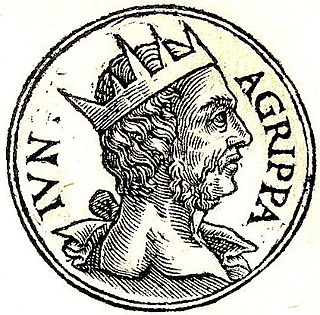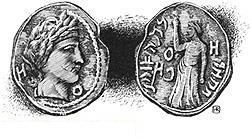Related Research Articles

Herod Agrippa was a King of Judea from AD 41 to 44. He was the last ruler with the royal title reigning over Judea and the father of Herod Agrippa II, the last king from the Herodian dynasty. The grandson of Herod the Great and son of Aristobulus IV and Berenice, he is the king named Herod in the Acts of the Apostles 12:1: "Herod (Agrippa)".

Herod Agrippa II, officially named Marcus Julius Agrippa and sometimes shortened to Agrippa, was the last ruler from the Herodian dynasty, reigning over territories outside of Judea as a Roman client. Agrippa II fled Jerusalem in 66, fearing the Jewish uprising and supported the Roman side in the First Jewish–Roman War.
Hiram I was the Phoenician king of Tyre according to the Hebrew Bible. His regnal years have been calculated by some as 980 to 947 BC, in succession to his father, Abibaal. Hiram was succeeded as king of Tyre by his son Baal-Eser I. Hiram is also mentioned in the writings of Menander of Ephesus, as preserved in Josephus's Against Apion, which adds to the biblical account. According to Josephus, Hiram lived for 53 years and reigned 34.

The Hasmonean dynasty was a ruling dynasty of Judea and surrounding regions during classical antiquity, from c. 140 BCE to 37 BCE. Between c. 140 and c. 116 BCE the dynasty ruled Judea semi-autonomously from the Seleucid Empire, and from roughly 110 BCE, with the empire disintegrating, Judea gained further autonomy and expanded into the neighboring regions of Samaria, Galilee, Iturea, Perea, and Idumea. Some modern scholars regard the Hasmonean realm as an independent Israel. The Hasmonean rulers took the Greek title basileus. Forces of the Roman Republic conquered the Hasmonean kingdom in 63 BCE; Herod the Great displaced the last reigning Hasmonean client-rulers in 37 BCE.
The Sadducees were a socio-religious sect of Jewish people who were active in Judea during the Second Temple period, from the second century BCE through the destruction of the Temple in 70 CE. The Sadducees are often compared to other contemporaneous sects, including the Pharisees and the Essenes.

Herod Antipas, was a 1st-century ruler of Galilee and Perea, who bore the title of tetrarch and is referred to as both "Herod the Tetrarch" and "King Herod" in the New Testament, although he never held the title of king. He was a son of Herod the Great and a grandson of Antipater the Idumaean. He is widely known today for accounts in the New Testament of his role in events that led to the executions of John the Baptist and Jesus of Nazareth.
Theudas was a Jewish rebel of the 1st century AD. Scholars attribute to his name a Greek etymology possibly meant as "flowing with water", although with a Hellenist-styled ending. At some point between 44 and 46 AD, Theudas led his followers in a short-lived revolt.
The Zealots were a political movement in 1st-century Second Temple Judaism which sought to incite the people of Judea Province to rebel against the Roman Empire and expel it from the Holy Land by force of arms, most notably during the First Jewish–Roman War (66–70). Zealotry was the term used by Josephus for a "fourth sect" or "fourth Jewish philosophy" during this period.

The life of Jesus in the New Testament is primarily outlined in the four canonical gospels, which includes his genealogy and nativity, public ministry, passion, prophecy, resurrection and ascension. Other parts of the New Testament – such as the Pauline epistles which were likely written within 20 to 30 years of each other, and which include references to key episodes in Jesus' life, such as the Last Supper, and the Acts of the Apostles, which includes more references to the Ascension episode than the canonical gospels – also expound upon the life of Jesus. In addition to these biblical texts, there are extra-biblical texts that Christians believe make reference to certain events in the life of Jesus, such as Josephus on Jesus and Tacitus on Christ.

John 4 is the fourth chapter of the Gospel of John in the New Testament of the Christian Bible. The major part of this chapter recalls Jesus' interaction with the Samaritan woman at the well in Sychar. In verses 43-54, he returns to Galilee, where he heals a royal official's son.

Aretas IV Philopatris was the King of the Nabataeans from roughly 9 BC to AD 40.

Luke 6 is the sixth chapter of the Gospel of Luke in the New Testament of the Christian Bible, traditionally attributed to Luke the Evangelist, a companion of Paul the Apostle on his missionary journeys. Jesus' teaching about the Sabbath enrages the religious authorities and deepens their conflict. The selection of twelve apostles is recounted and this is followed by the "Sermon on the Plain", where key aspects of Jesus' teaching are presented.

Luke 9 is the ninth chapter of the Gospel of Luke in the New Testament of the Christian Bible. It records the sending of the twelve disciples, several great miracles performed by Jesus, the story of his transfiguration, Peter's confession and the final departure from Galilee towards Jerusalem. Scottish minister William Robertson Nicoll describes this chapter as unfolding "sundry particulars which together form the closing scenes of the Galilean ministry". The book containing this chapter is anonymous, but early Christian tradition uniformly affirmed that Luke the Evangelist composed this Gospel as well as the Acts of the Apostles.
Matthew 15:21 is a verse in the fifteenth chapter of the Gospel of Matthew in the New Testament.

Acts 12 is the twelfth chapter of the Acts of the Apostles in the New Testament of the Christian Bible. It records the death of the first apostle, James, son of Zebedee, followed by the miraculous escape of Peter from prison, the death of Herod Agrippa I, and the early ministry of Barnabas and Paul of Tarsus. The book containing this chapter is anonymous, but early Christian tradition uniformly affirmed that Luke composed this book as well as the Gospel of Luke.

Acts 11 is the eleventh chapter of the Acts of the Apostles in the New Testament of the Christian Bible. It records that Saint Peter defends his visit to Cornelius in Caesarea and retells his vision prior to the meeting as well as the pouring of Holy Spirit during the meeting. The book containing this chapter is anonymous but early Christian tradition uniformly affirmed that Luke composed this book as well as the Gospel of Luke.

Acts 21 is the twenty-first chapter of the Acts of the Apostles in the New Testament of the Christian Bible. It records the end of Paul's third missionary journey and his arrival and reception in Jerusalem. The book containing this chapter is anonymous, but early Christian tradition uniformly affirmed that Luke composed this book as well as the Gospel of Luke.

Abdashtart I was a king of the Phoenician city-state of Sidon who reigned from 365 BC to 352 BC following the death of his father, Baalshillem II.

Joel 3 is the third chapter of the Book of Joel in the Hebrew Bible or the Old Testament of the Christian Bible. This book contains the prophecies attributed to the prophet Joel from the seventh century BCE, and is a part of the Book of the Twelve Minor Prophets.

This article lists historical events that occurred between 1–100 in modern-day Lebanon or regarding its people.
References
- ↑ Elwell, Walter A; Comfort, Philip Wesley (2001). Tyndale Bible Dictionary. Tyndale House Publishers. p. 226. ISBN 978-0-8423-7089-9.
- ↑ Orr, James; Hunter, S. F. (1939). International Standard Bible Encyclopedia. Wm. B. Eerdmans Publishing Co.
- ↑ Acts 11:28-29
- ↑ Henry, Matthew; Williams, J. B. (1828). Exposition of the Old and New Testament, Volume 3. Towar. p. 806.; compare Gill, John, Gill's Exposition of the Entire Bible http://biblehub.com/commentaries/gill/acts/12.htm accessed 1 September 2015
- ↑ Brownrigg, Ronald (2001). Who's Who in the New Testament. Routledge. p. 21. ISBN 978-0-415-26036-7.